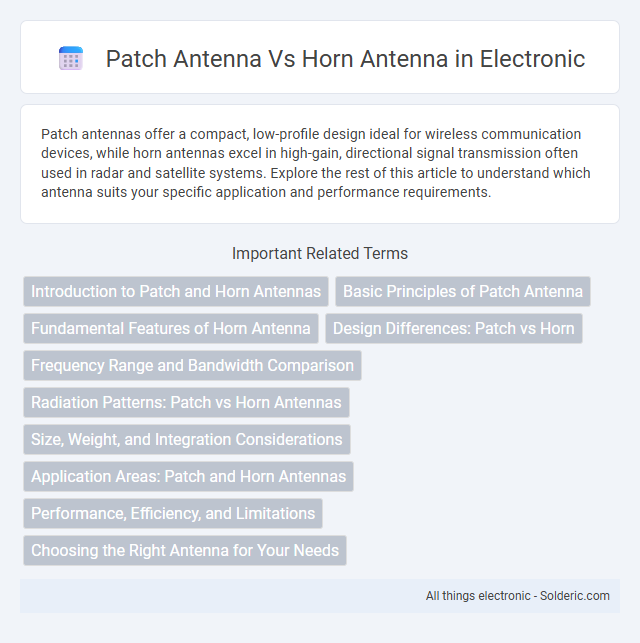Patch antennas offer a compact, low-profile design ideal for wireless communication devices, while horn antennas excel in high-gain, directional signal transmission often used in radar and satellite systems. Explore the rest of this article to understand which antenna suits your specific application and performance requirements.
Comparison Table
| Feature | Patch Antenna | Horn Antenna |
|---|---|---|
| Frequency Range | 1 GHz to 20 GHz | 1 GHz to 40 GHz |
| Gain | 5 to 9 dBi | 10 to 25 dBi |
| Radiation Pattern | Broadside, narrow beamwidth | Directive, high directivity |
| Size | Compact, low profile | Large, bulky |
| Impedance Bandwidth | Narrow, typically 2-5% | Wide, up to 20% |
| Polarization | Linear, circular (with design) | Linear, generally |
| Applications | Mobile devices, GPS, WLAN | Radar, satellite communication, measurement |
| Cost | Low to moderate | High |
Introduction to Patch and Horn Antennas
Patch antennas, known for their low profile and ease of fabrication, typically consist of a flat rectangular or circular metal patch mounted on a grounded substrate and are widely used in mobile and satellite communications. Horn antennas feature a flared metal waveguide that efficiently directs radio waves with high gain and directivity, making them ideal for radar and microwave applications. Understanding the distinct radiation patterns and frequency responses of your antenna choice is crucial for optimizing system performance.
Basic Principles of Patch Antenna
Patch antennas operate on the principle of microstrip technology, where a flat metallic patch is mounted over a grounded dielectric substrate to radiate electromagnetic waves efficiently. These antennas primarily function by exciting resonant modes on the patch, which acts as a radiating element with defined dimensions related to the wavelength of operation. Your design choices influence parameters like bandwidth and gain, making patch antennas suitable for compact, low-profile wireless communication systems.
Fundamental Features of Horn Antenna
Horn antennas exhibit fundamental features such as a flared metal waveguide that efficiently directs radio waves into a beam with low dispersion and high gain. They offer broad bandwidth and excellent impedance matching, making them suitable for high-frequency applications including microwave and satellite communications. Your choice of horn antenna ensures enhanced directivity and reduced signal reflection compared to other antenna types like patch antennas.
Design Differences: Patch vs Horn
Patch antennas feature a flat, planar design consisting of a metal patch mounted over a ground plane with a dielectric substrate in between, resulting in a compact, low-profile structure suitable for integration into printed circuit boards. Horn antennas have a flared metal waveguide that gradually expands to form a directional radiation pattern with high gain and wide bandwidth, commonly used in radar and microwave applications. The patch antenna's design emphasizes miniaturization and ease of fabrication, while the horn antenna prioritizes efficient energy transmission and higher directivity.
Frequency Range and Bandwidth Comparison
Patch antennas typically operate within a narrow frequency range, offering limited bandwidth usually between 2% to 5%, making them ideal for applications requiring compact size and specific frequency bands such as Wi-Fi and GPS. Horn antennas provide a much broader frequency range and wider bandwidth, often exceeding 30%, which enables them to support various microwave and radar systems effectively. Your choice between these antennas depends on whether you require wideband performance with high gain (horn) or a compact, low-profile design for narrowband applications (patch).
Radiation Patterns: Patch vs Horn Antennas
Patch antennas exhibit a directional radiation pattern with a relatively narrow beamwidth, making them ideal for applications requiring compact, planar designs and moderate gain. Horn antennas provide a highly directional and stable radiation pattern with higher gain and broader bandwidth, suitable for precise targeting and long-distance communication. Your choice depends on the need for compact form factor versus high directivity and efficiency in the radiation pattern.
Size, Weight, and Integration Considerations
Patch antennas offer a compact size and lightweight design ideal for integration into portable or space-constrained devices, making them suitable for modern wireless communication systems. Horn antennas, in contrast, tend to be larger and heavier due to their flared metal aperture, limiting their use in applications requiring minimal weight or space. Your choice depends on whether you prioritize easy integration and miniaturization with patch antennas or high-gain directional performance typically provided by horn antennas.
Application Areas: Patch and Horn Antennas
Patch antennas are widely used in compact wireless communication devices, GPS systems, and satellite applications due to their low profile and ease of integration with printed circuit boards. Horn antennas excel in radar systems, microwave communication, and satellite uplink/downlink facilities thanks to their high gain, directional radiation, and ability to handle high power. Your choice between patch and horn antennas depends primarily on the application's size constraints, frequency range, and required signal strength.
Performance, Efficiency, and Limitations
Patch antennas offer compact size and ease of integration with printed circuit boards, providing moderate gain and efficiency suitable for wireless communication systems. Horn antennas exhibit higher gain and efficiency, ideal for high-frequency applications such as radar and satellite communication, but are bulkier and less practical for compact devices. Limitations of patch antennas include narrow bandwidth and lower power handling, while horn antennas face challenges in size and weight, impacting portability and installation flexibility.
Choosing the Right Antenna for Your Needs
Patch antennas offer compact size, low profile, and easy integration into modern wireless devices, making them ideal for applications requiring portability and aesthetic design. Horn antennas provide high gain, wide bandwidth, and excellent directivity, suited for radar systems, satellite communication, and high-frequency testing environments. Your choice depends on whether you prioritize space-saving integration or performance in terms of gain and directivity.
patch antenna vs horn antenna Infographic

 solderic.com
solderic.com